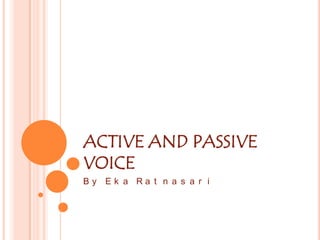Active and passive voice
•Download as PPTX, PDF•
3 likes•3,481 views
Report
Share
Report
Share

Recommended
Recommended
More Related Content
What's hot
What's hot (20)
Viewers also liked
Viewers also liked (15)
Ihlow october 2014 changing face of cambridge exams

Ihlow october 2014 changing face of cambridge exams
Similar to Active and passive voice
Similar to Active and passive voice (20)
Passive voice, Relative Clauses, Causative, and Subordinating Conjungtion. 

Passive voice, Relative Clauses, Causative, and Subordinating Conjungtion.
Recently uploaded
https://app.box.com/s/7hlvjxjalkrik7fb082xx3jk7xd7liz3TỔNG ÔN TẬP THI VÀO LỚP 10 MÔN TIẾNG ANH NĂM HỌC 2023 - 2024 CÓ ĐÁP ÁN (NGỮ Â...

TỔNG ÔN TẬP THI VÀO LỚP 10 MÔN TIẾNG ANH NĂM HỌC 2023 - 2024 CÓ ĐÁP ÁN (NGỮ Â...Nguyen Thanh Tu Collection
Recently uploaded (20)
Kodo Millet PPT made by Ghanshyam bairwa college of Agriculture kumher bhara...

Kodo Millet PPT made by Ghanshyam bairwa college of Agriculture kumher bhara...
TỔNG ÔN TẬP THI VÀO LỚP 10 MÔN TIẾNG ANH NĂM HỌC 2023 - 2024 CÓ ĐÁP ÁN (NGỮ Â...

TỔNG ÔN TẬP THI VÀO LỚP 10 MÔN TIẾNG ANH NĂM HỌC 2023 - 2024 CÓ ĐÁP ÁN (NGỮ Â...
UGC NET Paper 1 Mathematical Reasoning & Aptitude.pdf

UGC NET Paper 1 Mathematical Reasoning & Aptitude.pdf
Plant propagation: Sexual and Asexual propapagation.pptx

Plant propagation: Sexual and Asexual propapagation.pptx
Salient Features of India constitution especially power and functions

Salient Features of India constitution especially power and functions
Beyond_Borders_Understanding_Anime_and_Manga_Fandom_A_Comprehensive_Audience_...

Beyond_Borders_Understanding_Anime_and_Manga_Fandom_A_Comprehensive_Audience_...
On National Teacher Day, meet the 2024-25 Kenan Fellows

On National Teacher Day, meet the 2024-25 Kenan Fellows
NO1 Top Black Magic Specialist In Lahore Black magic In Pakistan Kala Ilam Ex...

NO1 Top Black Magic Specialist In Lahore Black magic In Pakistan Kala Ilam Ex...
Exploring_the_Narrative_Style_of_Amitav_Ghoshs_Gun_Island.pptx

Exploring_the_Narrative_Style_of_Amitav_Ghoshs_Gun_Island.pptx
Fostering Friendships - Enhancing Social Bonds in the Classroom

Fostering Friendships - Enhancing Social Bonds in the Classroom
Sensory_Experience_and_Emotional_Resonance_in_Gabriel_Okaras_The_Piano_and_Th...

Sensory_Experience_and_Emotional_Resonance_in_Gabriel_Okaras_The_Piano_and_Th...
Active and passive voice
- 1. ACTIVE AND PASSIVE VOICE By Ek a Ra t n a s a r i
- 2. ACTIVE AND PASSIVE VOICE VOICE is used to explain the subject acts or being acted upon. Active and Passive sentence usually have the same meaning but the focus is different.
- 3. ACTIVE VOICE ACTIVE VOICE: the subject performs the action expressed. Ex: Bob mailed the package Agent Verb Recipient The main focus in this sentence is on the agent that does the action
- 4. ACTIVE VOICE Here are another examples o The news surprises me o Mary is helping John o Mr. Lee will teach my class o Shirley has suggested a new idea o Cathy had returned the book to the library
- 5. PASSIVE VOICE PASSIVE VOICE: the recipient has something done to it by the agent. Ex: The package was mailed by Bob Recipient Verb Agent The main focus in this sentence is on the recipient that receives the action.
- 6. PASSIVE VOICE Here are another examples o I am surprised by the news o John is being helped by Mary o My class will be taught by Mr. Lee o A new idea has been suggested by Shirley o The book had been returned to the library by Cathy
- 7. PASSIVE VOICE Sometimes in passive sentence, the agent is left out. Ex: The rain soaked the pitch The pitch was soaked by the rain Usually the passive sentence is used without a “by phrase”. The passive is most frequently used when it is not known or important to know exactly who performs an action.
- 8. PASSIVE VOICE Only the transitive verbs (verbs that are followed by an object) are used in the passive. It is not possible to use verbs such as happen, sleep, come, and seem (intransitive verbs) in the passive. The progressive forms of the present perfect, past perfect, future, and future perfect are rarely used in the passive. Ex: John will have been helped by Mary
- 9. PASSIVE VOICE Either an indirect object (I.O) or a direct object (D.O) may become the subject of a passive sentence. Ex: Someone gave Prof. James an award (active) I.O D.O Prof. James was given an award An award was given to Prof. James When the D.O becomes the subject, to is usually used in front of the I.O*
- 10. PASSIVE VOICE *The omission of to is more common in British English than American English Ex: An award was given Prof. James
- 11. PASSIVE VOICE STATIVE PASSIVE: When the passive form expresses an existing state rather than action Ex: Now the door is locked locked is a past participle. It is used as an adjectives and describes the door o Often stative passive verbs are followed by a preposition other than by Ex: I am interested in Javanese art
- 12. PASSIVE VOICE Get may also be followed by a past participle. The past participle functions as an adjective; it describes the subject. Ex: Kyla got worried because Ron was two hours late